11+ Best Shopify Music Store Examples & How to Build one?
Having a passion for music and earning a living from doing what you love is one of the most satisfying ways of life. Whether music is your full-time job or just a side gig as a hobby, selling music online is a great way to make money from your creativity. As more artists are relying on cloud-based services to store their creation and sell on multi channels, it is no surprise that Shopify has become a top choice for a music store.
That said, there is a lot of risk when joining the music industry. For many musicians, a profitable music career is just out of reach with no guarantee of success. But, a new year is coming now, and musicians in 2021 have more tools than ever to reduce the risk and take a chance on their dream careers.
Exclusive Offer: Get Shopify 33 days for just $1 + The Online Store Starter Kit
Start your 3-day free trial, and enjoy your first month of Shopify for 1$ plus the premium package designed especially for new Shopify merchants!
By creating diversified and automated revenue streams, these Shopify music store examples can deliver new songs, sell merchandise and music equipment, and provide special courses that attract the masses. Let’s see those high functioning music stores from big musicians and learn how to create one for your own.
Rock on!
Read more:
- Best Shopify Jewelry Store Examples & How To Build
- Best Shopify Clothing Store Examples & How to Build One?
11 Best Shopify music store examples:
A website has become increasingly important for musicians, since it can set up a flexible online store with engaging elements - which showcase the artist’s personalities and help grow the fanbase. This is really important in the music industry, particularly bands who work hard to be creative, special, and even unusual to have an identity that listeners can’t find anywhere else.
These next Shopify music store examples will showcase how to create an unique experience while smoothing the music listeners’ shopping experience. You may want to put on headphones for this.
Billie Eilish’s Shopify music store

One of the hottest young names in the music industry right now is Billie Eilish. Whatever she wears can be sold out in minutes, so naturally the 18-year-old artist has her merchandise.
The website is simple with black and neon green - the singer’s favorite color, you can see it on her hair too. If you scroll down, you will see more merch and that is about it. The navigation bar helps visitors find products on apparel, music, accessories, and album-related items. There is no search field, so buyers can get a bit frustrated.
There are some rooms for improvement as an eCommerce music store, such as a product filter, more photos, and a better designed navigation bar. Overall, you can feel Billie Eilish’s personalities with the colors and simplicity of the website.
Lollapalooza’s Shopify music store
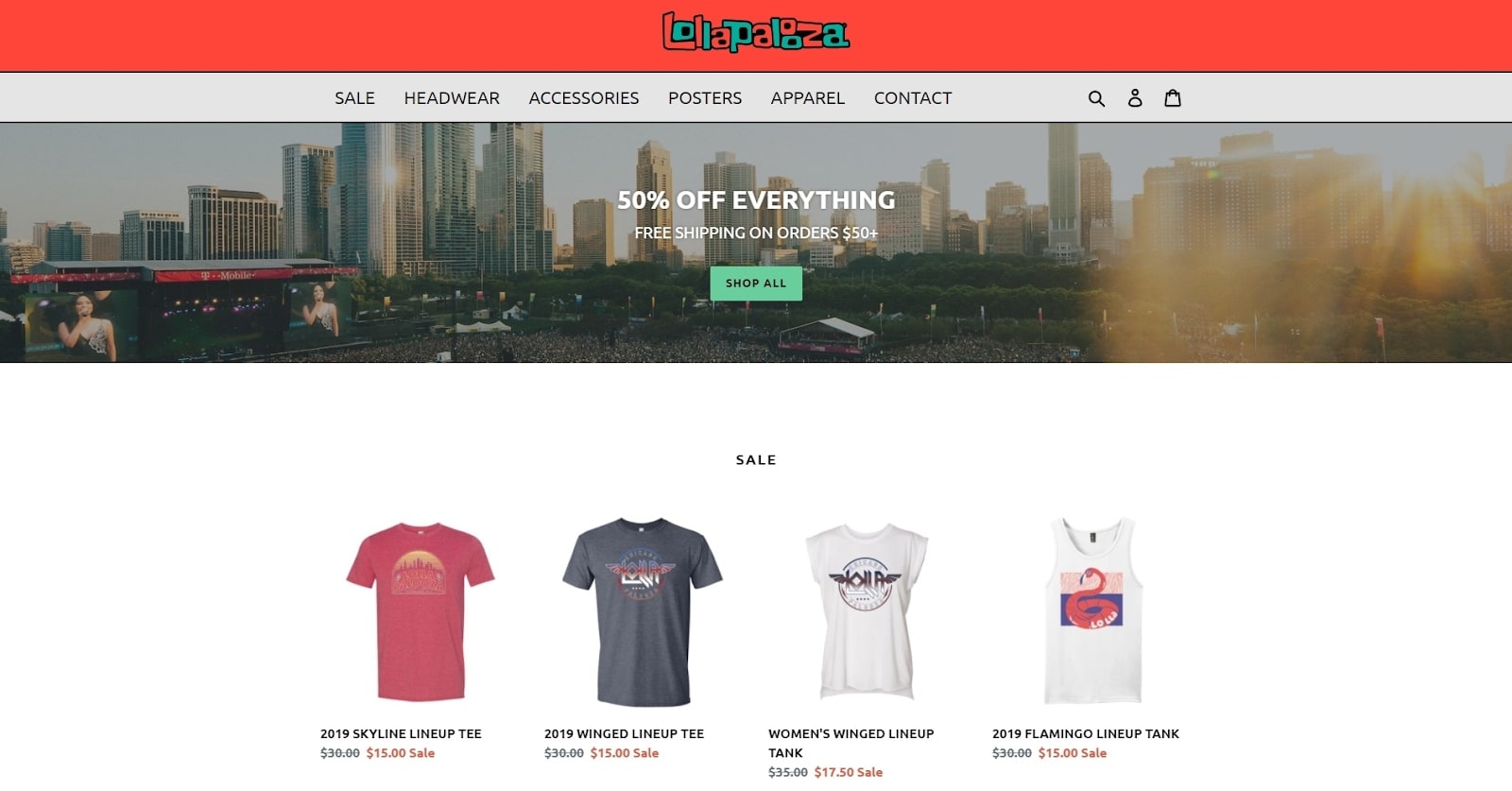
Lollapalooza is an annual 4 day music festival in Chicago. The show has grown to be one of the most popular music festivals in America, featuring popular artists of all genres from alternative rock, heavy metal, punk rock, hip hop, and EDM, with dancers and comedy performers. Lollapalooza caters to its huge fan base by offering exclusive merchandise from its jazzy Shopify store.
The store has a good mix of simple colors, with the banner constantly changing its colors, having a really festive atmosphere. The merch store ties in with Lollapalooza’s main site, creating a coherent and professional look. On the homepage, you can find many products with clear prices. The sale items are on display so the conversion rate can be boosted.
Overall, this is a pretty smooth eCommerce music store where shoppers can easily find all the necessary information. There is a search box, products have plenty of information, and the site is easy to navigate. I can’t ask more from a music store.
Beyonce’s Shopify music store
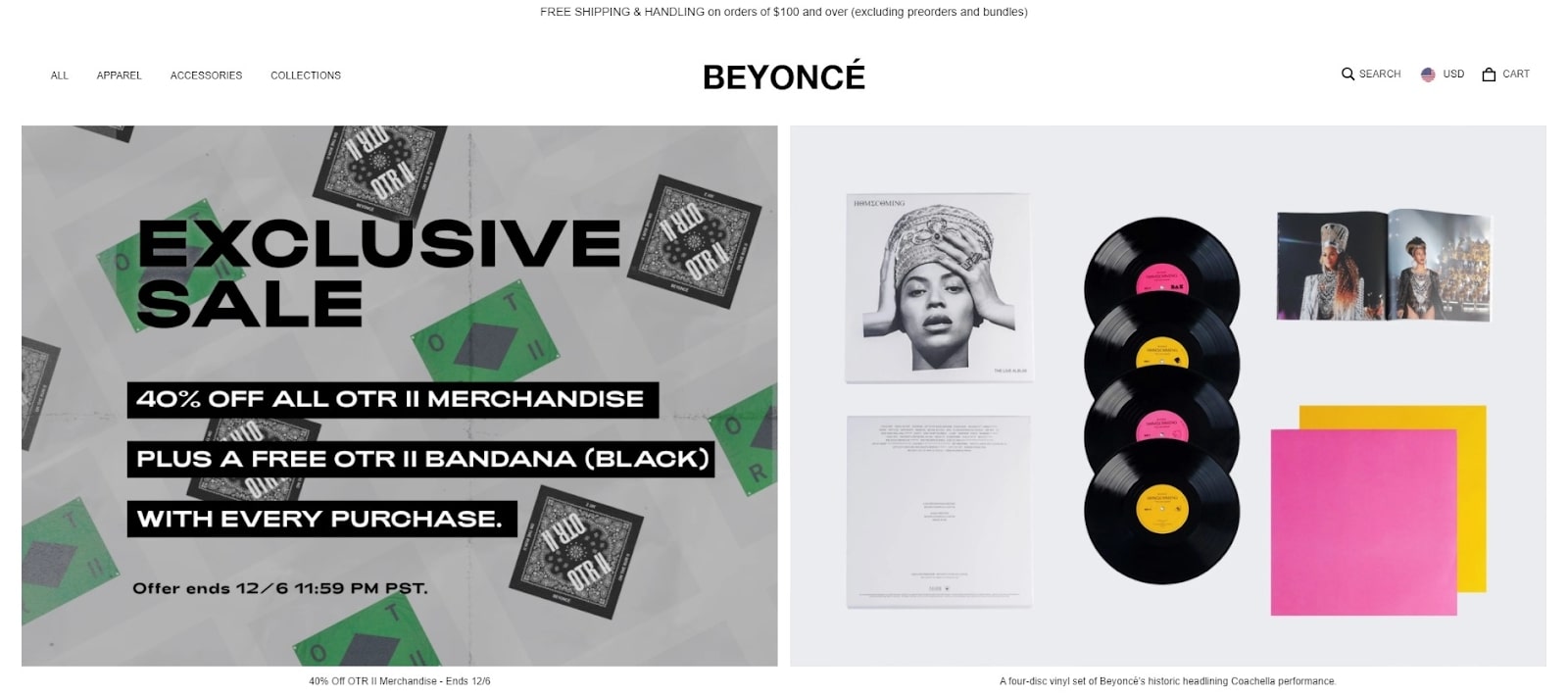
Queen Bee needs a reliable eCommerce platform that can handle the hundreds of thousands of fans rushing to buy some of her official merchandise. In April 2019, the release of her Netflix documentary Homecoming and accompanying album led to six time more monthly visitors. But, with Shopify Plus, her store didn’t crash for just one second.
Beyone’s Shopify music store keeps it simple but uses bold fonts of the timeless Helvetica to highlight its sales. The site looks clean with a modern and refined look. Even on the product pages, large product images pop against the white background, while sticky product details provide an unique touch.
Also, the store has a currency selector, a search box, and image-changing previews. In my research, this is the best eCommerce music store that has a good shopping experience and still represents the artist well. Queen Bee knows how to sell just like how to make good music.
Bastille’s Shopify music store
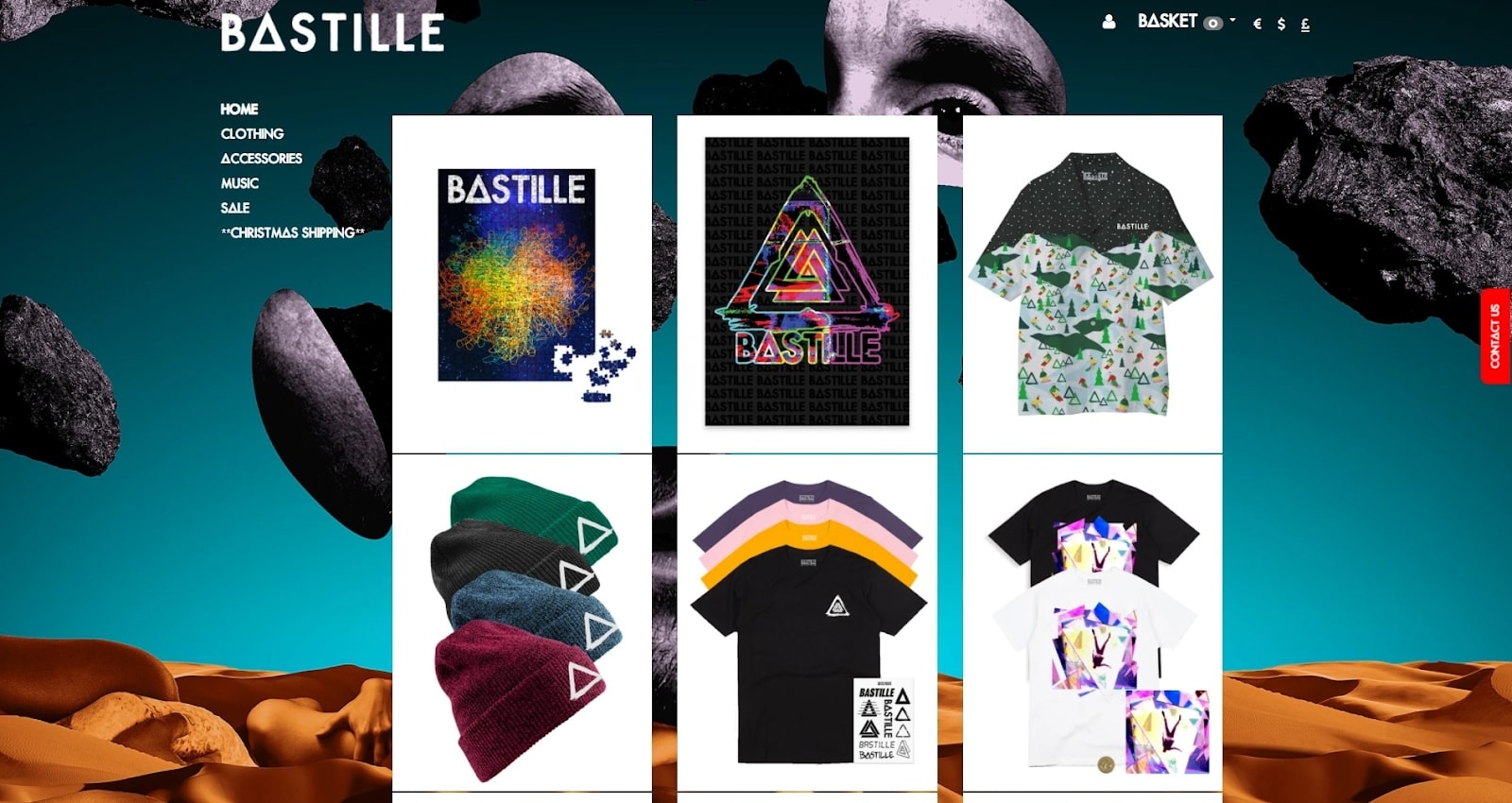
British band Bastille sell their music and merchandise via a Shopify store, which runs as a subdomain of the official site. The background image is immediately very eye-catching, being the cover of the band’s latest EP. The logo fonts used across the site are also interesting. This reinforces the band’s identity.
When a visitor hovers the mouse over a product on the homepage, they can see the name and price information. However, Bastille can consider adding size availability on that mouseover function to streamline the user experience. Over on the product page, they can use a larger selector and more obvious icons to provide a better mobile experience.
Newbury Comics’ Shopify music store
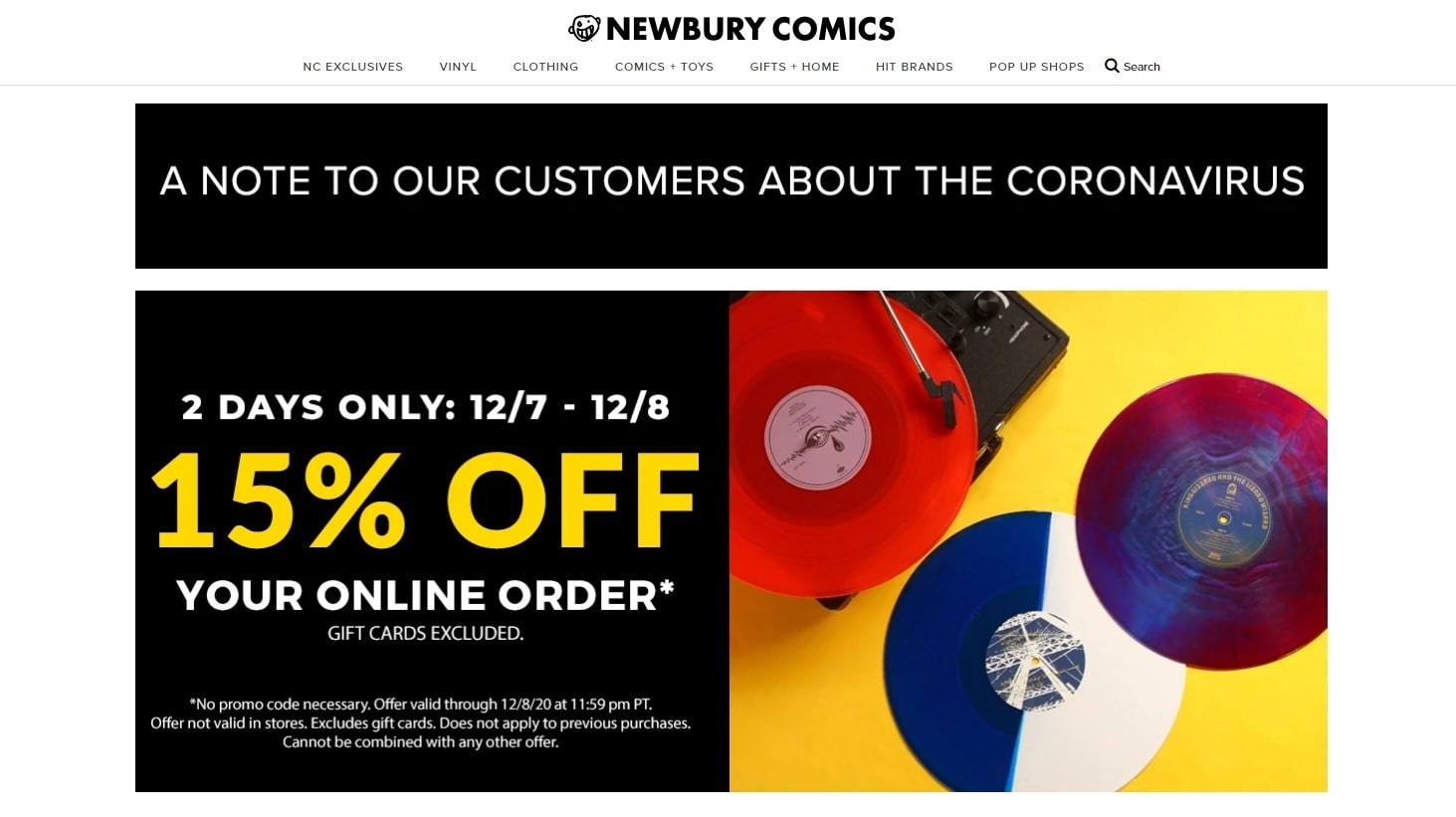
Newbury Comics is an independently owned retailer that sells music and pop culture merchandise. They provide an extensive offering of CDs and vinyls from all kinds of musical genres. This is a must-visit site for music enthusiasts. The Shopify music store receives between 200-300k visits per month.
The online store immediately shows an established feel thanks to the use of high-quality images and product photography. There are also extensive details for music geeks looking for products. You can tell the brand knows about music and pop culture simply through the design and professional presentation.
While the company selects only a few images to draw users’ attention, they can make the menu more visually appealing with moving images. Also, the site is not showing customer reviews - which is a huge wasted opportunity. Buyers are much more likely to convert if they can see authentic social proof.
Free 1:1 Shopify consultation & 30-day all-app trial FREE
- Shopify Plus Strategy and Consultation
- Personalized E-commerce Solutions
- Conversion Rate Boosting Techniques
- Inventory Management Hacks
Lady Gaga’s Shopify music store
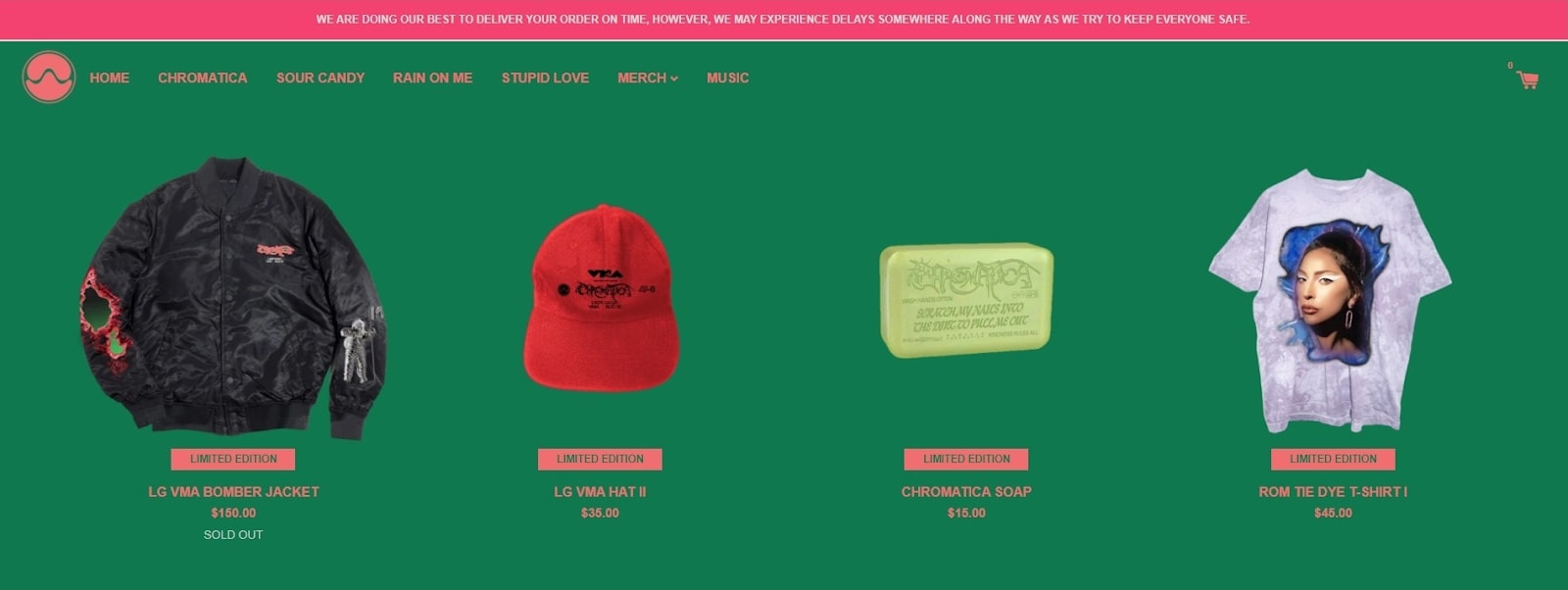
With Little Monsters all over the world looking to buy her clothing, accessories, and vinyls, it is no surprise that Lady Gaga needs a reliable store for her merch. So she puts on a Shopify Plus store and sells all her products plus album-related items.
The site is super minimal, which lets pages have a very quick load time. Eager fans would really appreciate this. You know the frustration when failing to buy an item because the site is lagging. The use of GIFs to present products is interesting as an interactive touch.
Lady Gaga’s site has the same problems with Billie Eilish’s store: no search field, no dropdown functionality, and no filtration. There are few items, but this is still a bad user experience if buyers want to search for specific items. Having a product page for each album is a good idea, though, since buyers can switch between different media types.
Shoreline Music’s Shopify music store
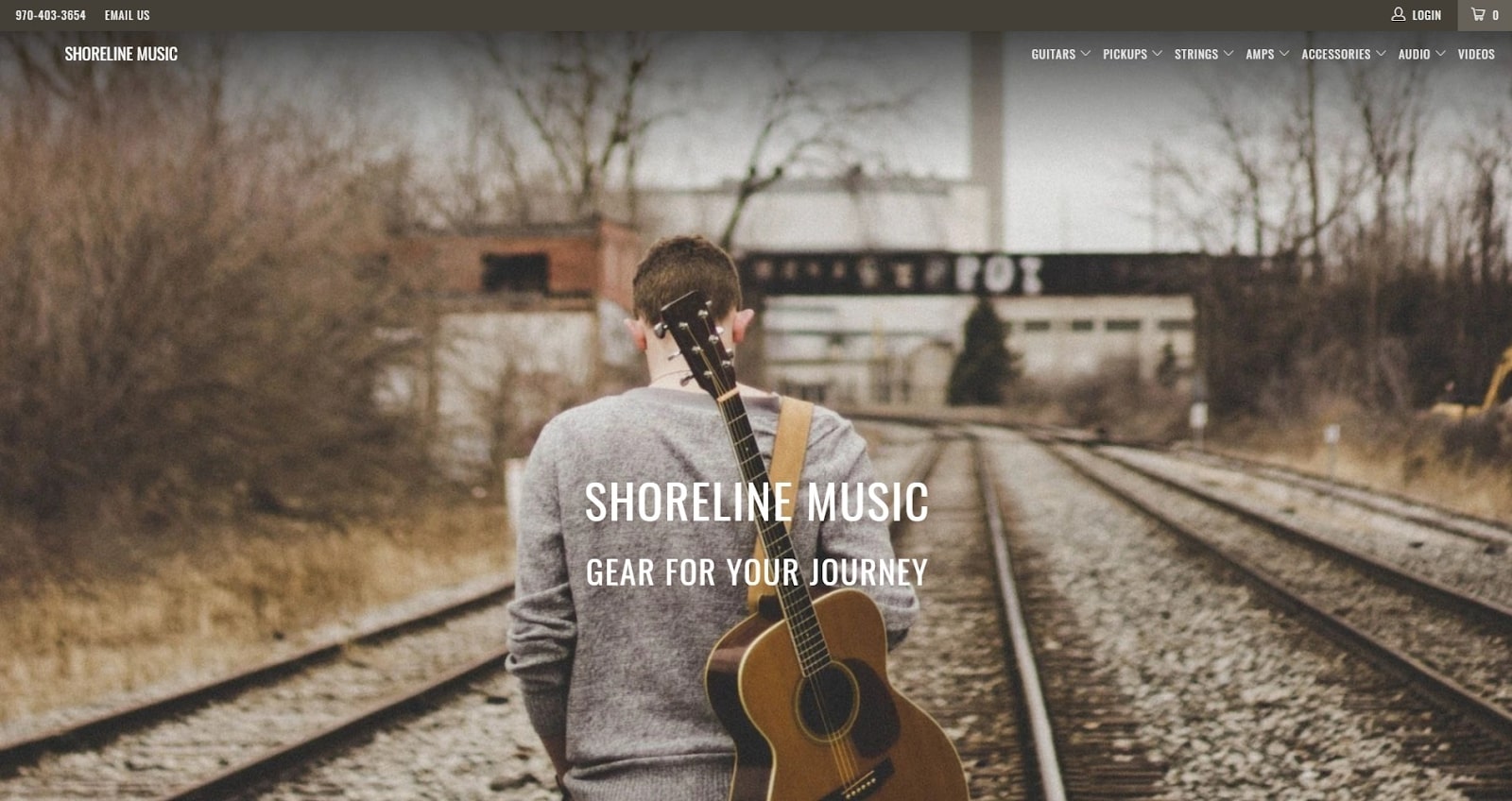
Shoreline Music is a special store, since it is one of the first online musical instrument sellers ever. Started in 1995, it was before eBay, Amazon, and even Google. Based on the owner’s passion, the store sells what it likes and grows based on word of mouth. The approach of creating a highly curated sore on musical instruments did them well and established a position on the market.
The store’s design is simple with a dropdown navigation bar as the main tool for buyers to browse through products. Music enthusiasts can choose from a large selection of guitars, pickups, strings, amps, accessories, and more. Just a mouseover on the bar and visitors can see all the available lines of products.
However, the site is not too friendly for beginners. I mean, how am I supposed to know the difference between Anderson guitars and Lakewood guitar? There is no search box and filters, so shoppers can’t find instruments based on colors and types. This is something that the store can definitely improve on.
Post Malone’s Shopify music store
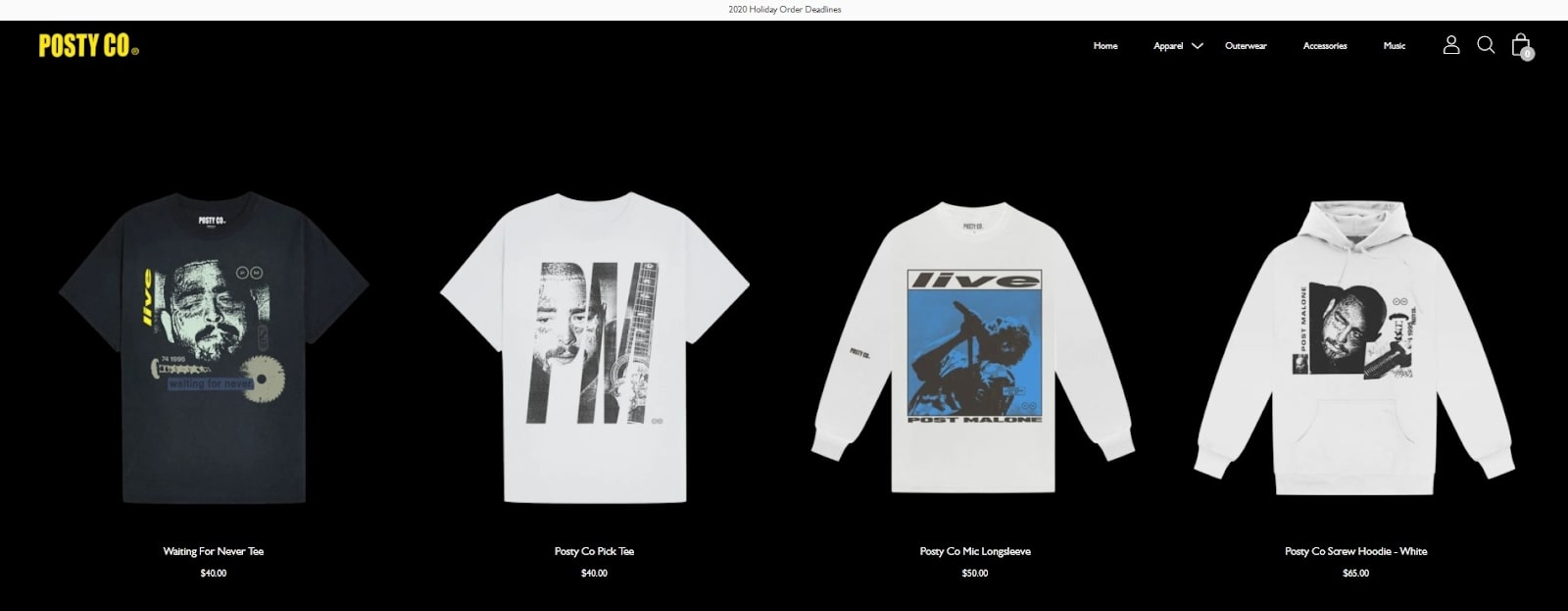
As one of the hottest names in the music industry right now, Post Malone has a lot of fans looking for a site to buy his merch. The site keeps it simple just like Lady Gaga’s store, using a plain black background. This helps the products pop out more, as you can see in the picture.
The good news is that Post has a search field and filter for his eCommerce site. Fans can easily look for items and filter them by Best selling, Low to high price, or New to old date and vice versa. The navigation bar is also friendly, as it shows products by categories. However, I wish there was another option to browse by albums.
One thing that bothers me is that so many artists choose this approach for their merch stores. A simple design is no doubt making the website faster, but how can it differentiate the store from those of other artists? This is a question for your own Shopify music store too.
Time + Space’s Shopify music store
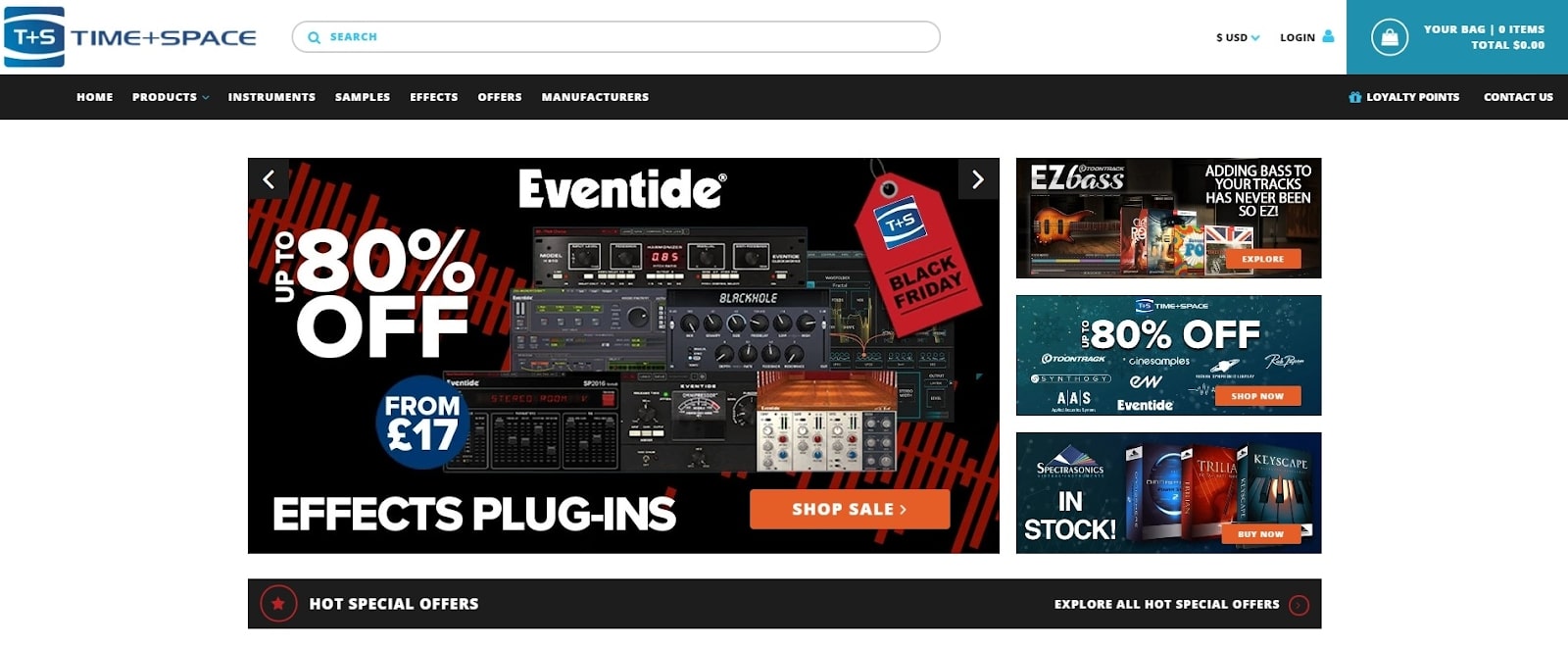
For over twenty years, Time + Space has supplied artists, composers, music producers, audio professionals, music arrangers, and creatives with premium tools to produce high quality music. They offer premium virtual instruments, sample packs, music production hardware, and effect plugins from world’s leading suppliers to make computer-based music.
The search bar is immediately a highlight with predictive search results. Users who have a specific product in mind wouldn’t have to go through a ton of items to find their desired item. The inclusion of user reviews as a star rating is also so beneficial to move shoppers down the purchase funnel.
The store also has a loyalty program just like a professional eCommerce store. Time + Space does a great job of explaining the loyalty program benefits and how customers can earn points or use points. This is a store to learn from if you want to sell music online.
Radiohead’s Shopify music store
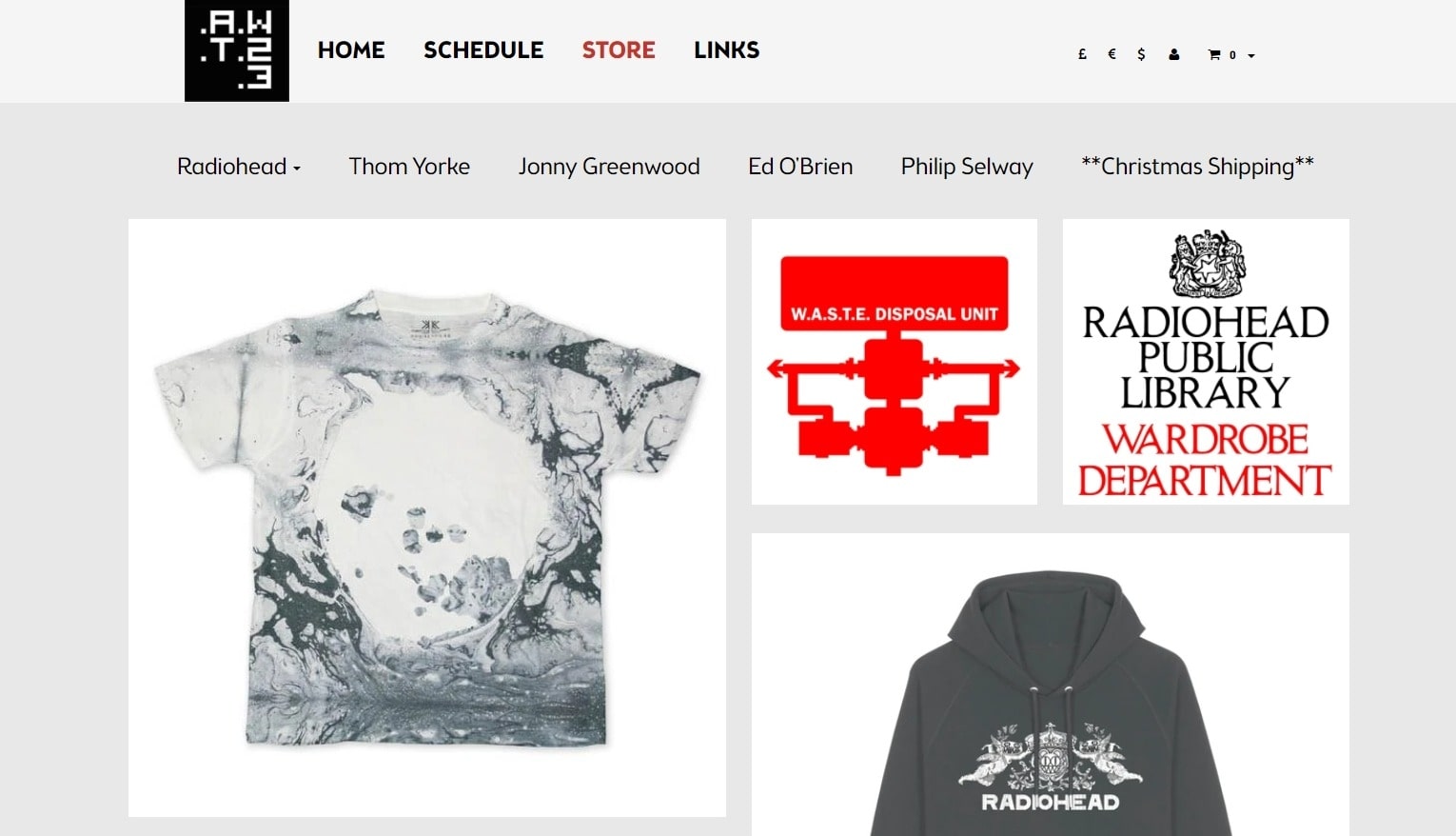
Fans of the legendary alternative rock band Radiohead can purchase their official merch on the W.A.S.T.E Headquarters Shopify store. Customers can buy branded clothing, posters, songbooks, and even children’s merch.
The use of a grey background helps white-background product images stand out more and resonates with Radiohead’s identity. They have portrayed a subtle theme of defiance and rebellion over decades, so a touch of disorganizing is suitable. Shopping by artists is also interesting since fans can delve deeper into the brand’s world.
However, Radiohead can improve the font for product names and prices to stand out more when a visitor hovers over product images. On the product pages, they can improve the selectors. It can be a good idea to use more iconography instead of a simple drop-down selector.
Haim’s Shopify music store
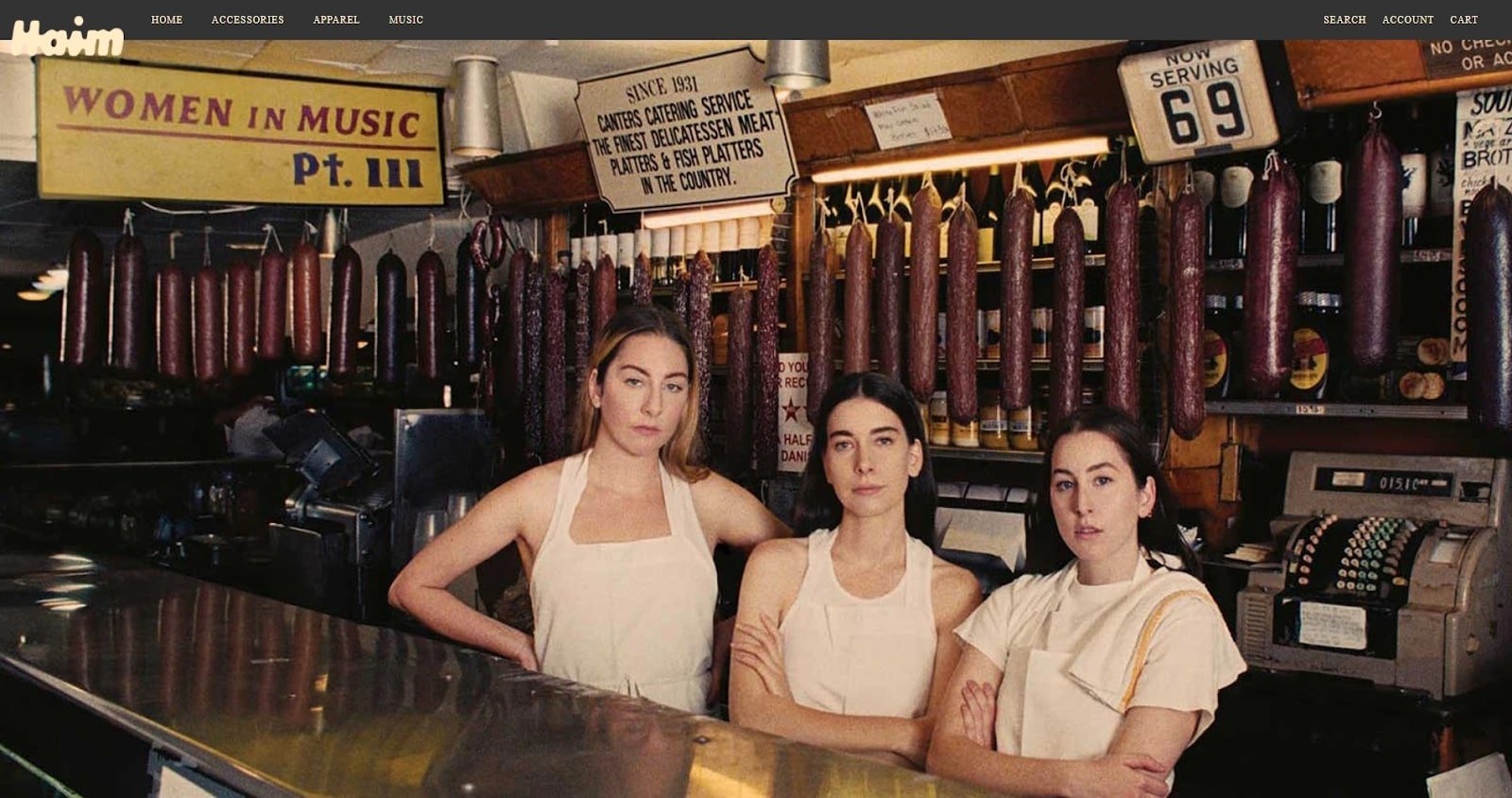
Haim is one of my favorite personalities in the music industry. As the pop-rock sibling trio find new ways to make their music interesting, their eCommerce store helps sell quirky tees and sweatshirts to fans. The store shows how a Shopify store can be customized to match an artist’s unique personality.
The design is a bit unorthodox and doesn’t conform to a standard online store layout. You can see the editorial style going on here with large lifestyle images and an interesting font choice. There are no product photos at the top, there is only the Haim sisters themselves. This is engaging and bold.
They use large imagery well with clear pricing, but don’t display availability or size ranges for preview. The font also sometimes hurts the user experience as it can blend into white buttons. The mobile version can be confusing, too, as customers can only see the products but not the price.
Why is Shopify a good choice for musicians?
Artists know more about changing than anyone. They need to have constant changes in music styles and personalities to show the growth in their music. For that reason, Shopify is the perfect option to build and maintain a customizable online store, while engaging with fans through providing merchandise.
Musicians, music producers, companies, and instrument sellers can create a go-to spot for consumers to immediately access merch and tracks. Being flexible as it is, the Shopify platform still has a reliable backend for a sudden surge of traffic or purchases. This is really important for musicians who want to make a big marketing plan for their albums or new merch collections.
As well as artists and bands, an increasing number of brands within the music industry have used the platform to sell audio and recording equipment. There are also many apps to streamline the working process, so owners can focus on what they do best - creating music.
Shopify is the ideal option to start selling music products at only $29 per month with an orchestra of features.
How to build a Shopify music store?

With Shopify, you can set up a fully automated merchandise online store in minutes. Start by deciding what you are going to sell on the site.
1. Deciding on the products
Music albums, vinyls, t-shirts are the most common types of products. But print-on-demand companies can help you offer a wide range of products, from canvas bags to water bottles, key chains, and home decor products.
If you are a producer, a common way to earn money is by selling beats and samples. This is even the primary income for some producers. Also, you can use your store to provide training services. Teaching the next generation of artists is a great accomplishment with a very fulfilling feeling.
2. Creating your Shopify music store
The process of creating a Shopify store is easy and straightforward since Shopify made it easy for users to build an online store only by dragging and dropping. The important part is building a smooth shopping journey from start to finish, because you are also helping your fans with a good buying experience.

The first thing to do is picking a template. Shopify Theme Store has 73 pre-made templates that you can customize for your own identity. The theme above is Label, and you can get it for just $160 with three styles included. The big hero image helps you establish your image immediately when visitors just get to your site. Scroll down and you will see all the music products have a clean and accessible design.
You can check out our top 10+ best Shopify music themes.
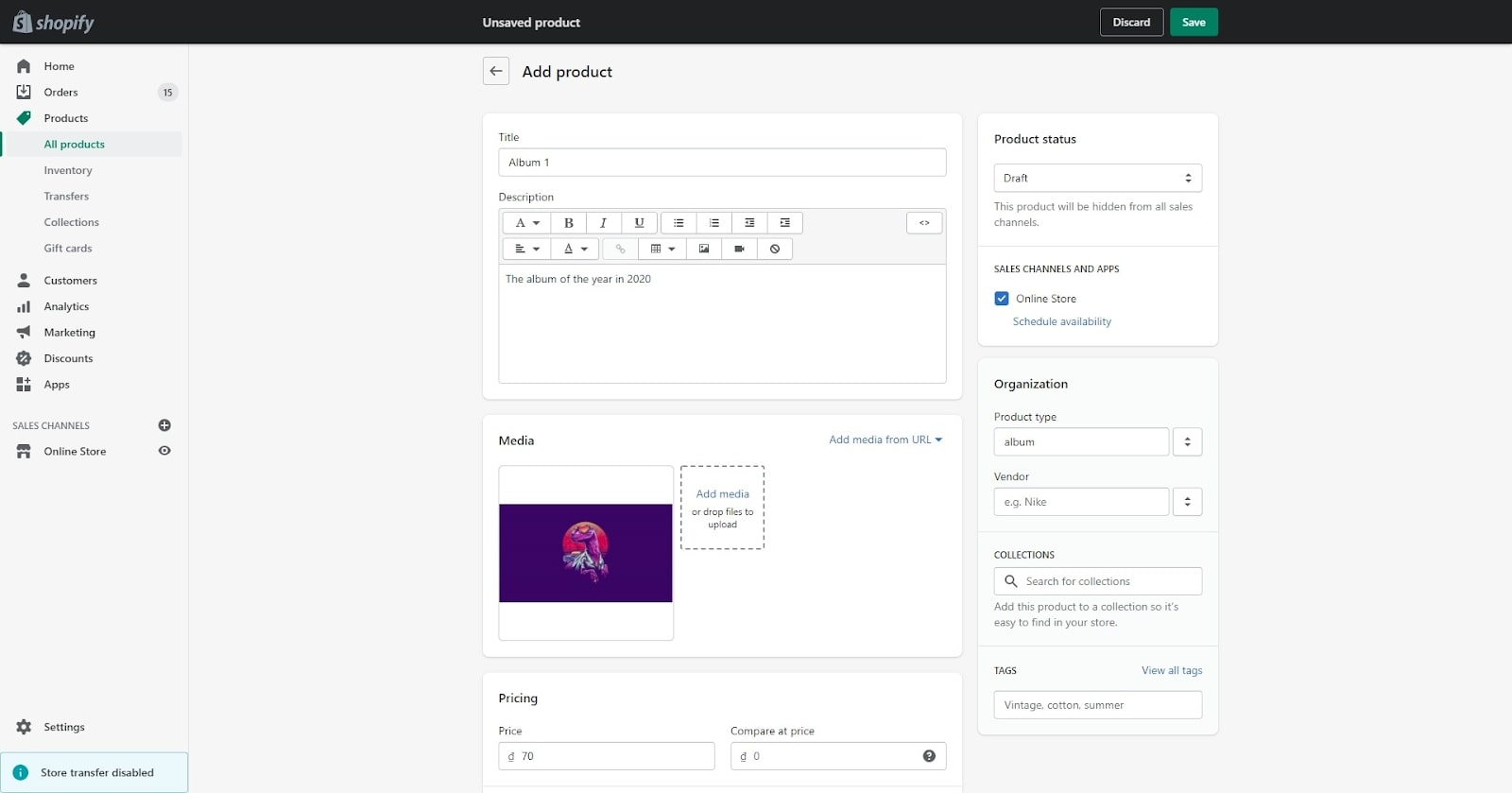
Next, you will need to add products and tweak the settings for your own preference. Once you sign up for an account, you can get access to the Shopify dashboard like in the image above. The product section lets you add product name, image, description, collections, and more. The setting section lets you tailor how your store functions.
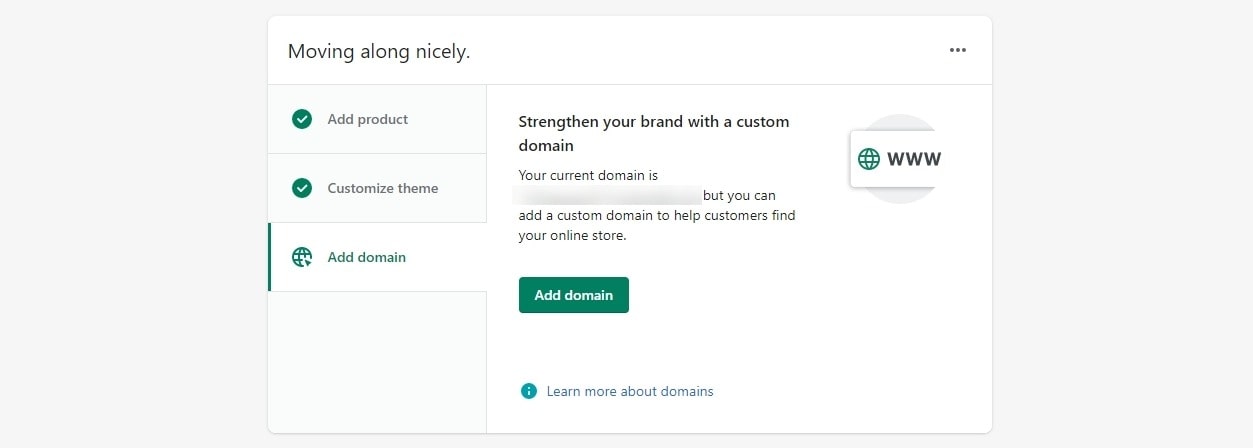
After that, all you need is a good domain name for your music store!. Most musicians would just use their names for the domain, but it is up to you. If you want to promote yourself as a teacher or a producer, you definitely can add that into the domain name. You can launch your store after this step.
Just take some times to make sure you have all the necessary settings in place, such as checkout methods, shipping, contact information, and a good mobile experience. Then you are good to start selling your music products!
3. Market your store and music
After deciding on what to sell and creating your Shopify music store, you need to find audiences. Understanding how you market your music is just as important as how your profit from it. Here are the essentials to market your music online:
- Build a social media following: Your social media accounts will be the communication gates to offer concert tickets, merch sales, update information, and show your talents. Make interacting with your fans a priority on these social media platforms, and you can engage with other musicians in the industry as well. Some social media services to try are Twitter, Instagram, Facebook, Twitch, and Reddit.
- Submit your works: Music blogs or Reddit threads are a great way to target a niche. You can also find local fans to come to your shows. However, these blogs and threads are free to submit, so you will need to stand out from other posts. Many are genre-specific, so don’t spam your music in the wrong places.
- Get on streaming services: Many streaming platforms suggest playlists based on algorithmic recommendations and users’ activities. Optimizing your playlists for these platforms can reach a large number of audiences, such as Spotify and Apple Music. You can find many guides for Spotify artist account optimization online.
- Make use of visual contents: Music videos are a great promotional tool for your music. To gain more followers and fans these days, you would need a strong video idea and a lot of uniqueness. An interesting video, whether cheap or expensive, is always more likely to go viral.
- Send email marketing campaigns: Many music enthusiasts don’t have the time to check every new update on social media and websites, so why not keep them in loop with newsletters? Your emails can also enhance the results of a new album or merch collections, as they can nurture a relationship through automated timing. Our app AVADA Email Marketing can help you do just that, click on the link to find out.
Recommendation: How to Build A Shopify T-shirt store?
Ready to make money with your music?
Nowadays, musicians rarely make money just by making music. They collect revenues from a system of diverse income streams that are manageable on automation, while they can focus on the most important part of their jobs: making good music.
Dumping tons of money won’t turn you into a music star. By understanding your audience and creating an awesome Shopify music store, you will be able to generate more revenue while providing an enjoyable connection to your fans. The examples in this article are the brightest proof.
So, put on your guitar and start making some jam, right after creating your own Shopify music store. Good luck and rock on!
Related Posts:
New Posts








